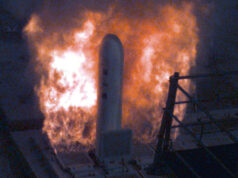Lockheed Martin has delivered the 500th Electro-Optical Targeting System (EOTS) for the F-35.
The firm say that all units have been delivered on time or ahead of schedule to support aircraft production and sustainment requirements.
“We are proud to bring superior capabilities to the F-35,” said Michael Williamson, vice president of Sensors & Global Sustainment at Lockheed Martin Missiles and Fire Control (MFC).
“We know how important this capability is to the warfighter and we continue to invest in our Advanced EOTS upgrade, which will bring extended capabilities to the cockpit.”
EOTS combines forward-looking infrared and infrared search and track functionality to provide F-35 pilots with precise air-to-air and air-to-ground targeting capability say Lockheed. EOTS allows aircrews to identify areas of interest, perform reconnaissance and precisely deliver laser and GPS-guided weapons.
The company also delivered the 4,000th Distributed Aperture System (DAS) Window for the F-35 recently. The DAS Window set consists of six polycrystalline silicon, low-observable, infrared transparent windows for Electro Optical (EO) DAS sensors on the F-35.
Each shipset of windows enables the EODAS sensor to provide threat detection and 360-degree situational awareness to the pilot.













Looks like a few EOTS ended up here too:
https://nationalinterest.org/blog/buzz/chinas-j-20-stealth-fighter-new-pictures-confirm-something-pretty-awful-62982
One trusts we’re nicking just as much of theirs.
When I was a kid I remember seeing lots of artist impressions and pictures of prototypes and shiny new kit and assuming naively that it meant that this wonderful new capability was up and running. Later in life I found out that it takes years of very hard graft and loads of money to make things work as intended. It’s taking the US years to get the F35 right and costing them an arm and a leg. I look at these pictures of this Chinese aeroplane and just smile… When several hundred are in front line service and fully worked up working as intended, I’ll sit up and take notice…
Said like A man who has been on the delivery end of a new ‘project’
Three major programmes
I totally agree. Another good example is the Typhoon, how long did that take to get to where it is now? By all rights, compared to a F35 it is not an overly complicated aircraft. Yet its development has been slow, perhaps hamstrung by political infighting. However, it’s the systems integration that takes time and the number of trials to prove and develop it.
The Chinese armed forces in the last 10 years have seen a quantum change in the type of kit they use. From the Soviet era copies, to equipment that on paper at least is comparable to Western equipment. However, how much real development has gone into them. All three services have seen new kit, from ships, tanks to aircraft. The rapid fielding to my mind is highly dubious and I suspect the actual quality and system integration is lacking.
A US Army officer recently reported on the Chinese infantry fighting vehicles operating Mali, saying they were very shoddy and wouldn’t stand up to much abuse. Is it all just for show or as Stalin said numbers have a quality of their own?
Western equipment goes through endless OT&E, certification, qualification and acceptance trials before being released to service. Then this is followed by intensive training of air and ground crews and the development of very comprehensive and all encompassing integrated logistics support and maintenance programmes. At times all this appears somewhat OTT, but it’s done for a reason. Russia and China may be able to bring equipment into service more quickly but like you, I question the validity of the claims made as to its efficacy.